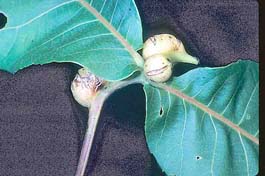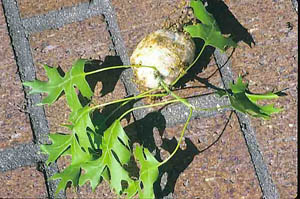Galls on Leaves | |
|---|---|
| June 9, 2008 | |
|
Bumps, or galls, are being spotted on leaves, twigs, roots, and flowers of many plants. Plant galls often appear as balls, knobs, lumps, or warts of various shapes, sizes, and colors. Galls develop from plant tissues that have been irritated and/or stimulated by a parasitic organism. One of the most common galls in Illinois is the maple bladder gall. The small, wartlike growth can easily be spotted on silver (soft) maple. Galls are first green, then turn red and finally black. Maple bladder galls are caused by eriophyid mites, mites that are tiny even for mites. Eriophyid mites are cigar-shaped and have only four legs, located behind the head. They are so small that a hand lens is needed to see them. The mites that cause maple bladder gall have several generations per year, so galls are produced through the growing season. Hackberry nipple gall forms a tiny nipple on the upper surface of hackberry leaves. So common is this gall that many people believe it is a natural part of hackberry leaves. The gall is first green and then turns purplish brown. It is caused by an adelgid, a close relative of aphids. Adelgids cause many leaf galls on hickory. Another common one is the hackberry blister gall, appearing as a yellowish, small, raised area on the leaf. Another adelgid causes the hackberry petiole gall, which is a kidney-shaped gall at the base of the leaf. Adult adelgids look like miniature cicadas, being 1/16 to 1/8 inch long. They emerge from the galls in the fall just before to just after leaf fall, and overwinter in protected sites. In some parts of the country, they enter houses in huge numbers, being small enough the go through window screening. The adults fly back to the trees to lay eggs during leaf expansion in the spring. The resulting nymphs cause the galls to form.  Hickory leaf stem gall. Hickory trees have many leaf and petiole galls that are caused by phylloxera, another sap-sucking insect that is a close relative of aphids. Many are very common in Illinois, with the most obvious galls appearing as round galls 1/4 to 1/2 inch in diameter. Some are spherical, and others are flattened on one or two sides. Because hickories are primarily forest trees rather than landscape trees in Illinois, they are not commonly noticed. Thousands of galls are found on oak trees, and almost all of them are caused by cynipid wasps. Adult cynipid wasps are smaller than pinheads and do not sting people. The largest cynipid galls are the oak apple galls, being spherical, hollow galls that mature to sizes up to 2 inches in diameter, depending on the species of cynipid and the oak host. The legless, white larva typical of cynipid wasps lives in a small, seedlike structure in the center of radiating fibers that extend to the inside edge of the gall. Although they are initially green, oak apple galls mature to tan galls with a hard, papery exterior.  Wool sower gall. Other common cynipid leaf galls include the following. Succulent oak gall appears as green to reddish marbles on pin oak. Wool sower gall is tan, spongy, and ping pong ball–sized. Many other oak leaf galls appear as round balls 1/4 to 1/2 inch in diameter that are smooth, covered with hairs, or cover with points, depending on the species of cynipid causing the gall to form. A particularly unusual gall is the jumping oak gall. This appears as pimples about one-quarter the size of pinheads on the leaves of white oak and bur oak. In the late summer and fall, they drop from the leaves and quiver or jump on the ground. Although they barely leave the ground when they jump, they are still very obvious in their movements. Although the galls are common and easy to see, they are seldom important enough to control. It is very uncommon that leaf galls need to be controlled. However, there are times when galls can be serious problems, but this is on stems and twigs rather than leaves. Gouty and horned oak galls occur on the branches of pin and shingle oaks, as well as a few others, though you seldom find the galls on white oaks and bur oaks. These galls do start out as leaf galls, but a secondary stage starts to invade the twigs and limbs. When that happens, knobs develop that can be smooth (gouty) or knotted. As the gall grows, it girdles the end of the branches, which can cause severe dieback to the trees. Unfortunately, there is no easy control of the gouty or horned oak galls. Hand pruning is effective, but may be impractical due to the quantity and size of trees. Improving the overall health of the tree with regular fertilizing and watering is critical. In severe cases, the galls may weaken the trees to the point where it’s better to remove the tree. Other general insect- and mite-produced galls disfigure twigs and foliage but rarely seriously affect the health and vigor of the host. Once gall formations become noticeable, the insect or mite causing the injury is protected from chemical sprays. It is too late to exercise any control other than removing the infested part. Hand-removal is only practical when few galls are present. Chemical sprays are seldom warranted where gall infestations are light. Plants with heavy infestation or those that are tremendously unsightly to homeowners can be treated. Spray treatments can be used to prevent future gall formation but must be correctly timed to eradicate the pest once it emerges and before it has time to induce the gall. Sprays applied after galls are formed are ineffective. Some gall-producing insect populations can be reduced with a dormant oil spray applied to trunk and branches in the early spring, just before buds open. This is effective in controlling Cooley spruce gall adelgid and eastern spruce gall adelgid. Some insecticides will control gall formation on elm, hickory, and maple leaves when thoroughly applied to foliage as buds are unfolding. Generally, these are contact insecticides, such as pyrethroids. To control most galls, foliage should be thoroughly sprayed before the leaves are fully expanded. It is nearly impossible to treat large established trees. Leaf galls are mainly an aesthetic problem.(David Robson and Phil Nixon) | |
| Author: | Phil Nixon |
